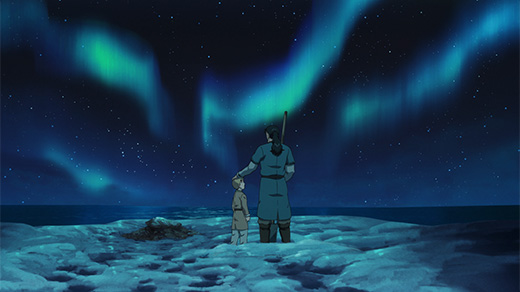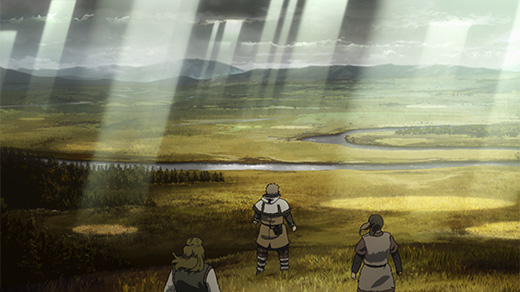SPECIAL
スペシャル
TV Anime VINLAND SAGA Season One
Broadcast and Global Stream Anniversary
Second Special Group Interview: Music Director: Shuhei Yabuta,Sound Effect Director: Shoji Hata, Music: Yutaka Yamada
The second season of TV anime VINLAND SAGA will start airing January 2023! And to celebrate the anniversary of the TV broadcast and worldwide streaming of Season One on Prime Video and Netflix, we’re releasing our second interview with the creators. This time, Director Shuhei Yabuta, Sound Effect Director Shoji Hata, and Music Yutaka Yamada have gathered to talk about the music in the show.
One cannot talk about VINLAND SAGA without talking about the music, so we hope you enjoy what everyone had to say!
SPOILER ALERT: Please note that this interview contains some spoilers about Season One.

How the Story’s Appeal Affected the Music Composition
I’d like to start with a question to Yamada and Hata. When you were working on the music for Season One, what did you find particularly appealing about the story?
- Yamada
- The depth with which the story showed the protagonist Thorfinn’s inner struggles, and the developments around him really struck me. When I read the script, I was impressed at how detailed and well-paced the story was written. Then when I sat down to compose the music, I figured that it would end up expressing the psychological depths of the characters, so I took these things into account while I was composing it.
- Hata
- I also felt a rawness in the dramatic structure and the depths of the story went with the emotions of each character when I read the original story. I had felt through discussions with Yabuta that he really wanted to emulate that emotional depth step by step in the anime series, so I decided to put my focus on that and go forward.
- Yabuta
- When I had my initial discussion with Hata, we spoke about what kind of scale of music we were talking about, given the setting of the story. I told him how if it’s not a super tense scene, I much prefer putting music to the feelings rather than the occurrences. While I knew of Yamada’s music, this was our first time working together. Though my request was terribly abstract, he got back to me with a demo of 26 really high-quality songs, all at once. I hadn’t done things the usual way, making a chart of songs I wanted and having him compose them. This was a bit of an adventure, leaving so much up to someone I’d been working with for the first time, but it worked out well.

Soundtrack Composition Behind the Scenes
Yamada, how did you make your 26-song demo?
- Yamada
- We didn’t speak about too many details in our meeting about VINLAND SAGA. Rather than practical things such as “this character feels this at this time,” I remember us going right into deeper issues, such as what we wanted to communicate through the show as a whole, or how we wanted the viewers to feel. We spoke for about an hour. Yabuta brought this up a moment ago and I’d like to reinforce it, but I felt that what this story needed wasn’t music to explain what was physically happening on screen. Even the songs that did express what was going on, I made sure to write in a way that gave them extra emotional weight.
I understand you’ve worked on a lot of fantasy shows, Yamada. How eager were you to get to work when this show was greenlit?
- Yamada
- I’ve worked on plenty of fantasy shows so far, but this was the first time I’d worked on something in 11th-century Europe instead of Japan, so I was highly motivated as I got to work. For me, taking on 26 songs at once with no strict specifications really freed me from limitations and let me put a lot of myself into the work.
I think that rather than looking at the story from the same point of view, bringing in ideas from other viewpoints will help you make a real beast of a story when you bring the art and music together, so I’m glad they let me go full power with composing from the get-go. - Hata
- It was like a big ball of passion came flying our way.
Structuring around Points of View
- Yabuta
- Yamada really covered the whole scope of the story in his work and threw me an incredibly clean pitch. The term he used, “point of view,” was also an excellent hint. Telling a story is all about the points of view, and I don’t think you can do it with visuals alone. You get points of view from sound effects, music—the power of audio. And it really felt like Yamada made his VINLAND SAGA, from his point of view.
So points of view are the key.
- Yabuta
- Indeed. Phenomena and points of view are completely different. To bring up an easy example, look at the finale of Season One. Just looking at the phenomena that happened to Thorfinn, I think most people would see it as a tragedy and feel that the years of his young life had all been wasted, and I think it was a big loss to Thorfinn himself. Still, if you change your point of view, you can change the meaning you get from it. You can portray it from the point of view of a man who’s hit rock bottom, or you can show it as Thorfinn expanding his world in a way and finding a path to the future. When I knew the story would end there, I tried to make sure the viewer would feel the latter.


Hata, could you tell us what you thought of how Yabuta dealt with the music?
- Hata
- He mentioned that he wanted to try doing a bit of the sound work himself in Season One, so I helped him with the technical details. In Season Two, however, he’d learned how to use ProTools and was able to completely do the sound editing on his own. He had a pretty solid audio vision from the start, and he stoically allotted sound to the scenes. It was a refreshing experience, really, and I ended up learning a surprising amount from it.
Yabuta, do you view the visuals and audio as being of equal importance?
- Yabuta
- I do. I think they’re completely side by side. I even thought this back when I was a viewer, before I made films myself. Hata took this all as fresh, and I’m glad he did, but I hadn’t thought about the audio when I was putting together the script and storyboards. I had to go through the music we had and see what kinds of experiences they gave me. I’m always looking for fresh experiences like that, wondering what kind of experience the viewer will get and from what point of view.
Synchronization of Visuals and Music
Yamada, can you tell us what you thought when you saw the actual show play out?
- Yamada
- There were plenty of scenes that stayed with me, but what shocked me the most was the use of the piano song in the first episode. I hadn’t played the piano with any particular emotion in mind, but on screen it was expressing not joy or sadness, it was more of reaching out to a memory deep within. I was really glad when I saw that. It felt like my music was being used with the animation in the way I’d always wanted it to be. It felt like making strong music without being directed to what songs to make really paid off.
Yabuta, what was your intent when you added that piano song to that scene?
- Yabuta
- I do talk about this a lot. When I’m thinking about which of Yamada’s songs I want to play for the visuals I’ve made, I’m also thinking of what I want to see while I’m listening to his songs. Visuals and music are as important as each other, yes, but you also have to consider time. With anime, the rhythm is generally decided by the editing, so you decide what parts are most important to you, and what flow you want to go with.
What isn’t set in stone, though, is that point of view I was talking about earlier. So when I matched Yamada’s music to my visuals and grappled with them together, I found there were a surprising amount of scenes where I didn’t have to edit the music at all.
Music mostly consisted of musical phrases with set rhythms and allotments of time. I think the same could be said of the rhythm of sections of film that add up to tell a story. This kind of progression of events is necessary in order to convey that in a particular scene. And you could say that Yamada’s music is a good match with the kind of rhythm I’m thinking about when working on the story. - Hata
- I feel the same way. Sometimes you’ll see a film or anime where the rhythm and development of the music and imagery are completely in sync. That really reflected in how well the director and the composer worked together. Everyone working on VINLAND SAGA felt like they were truly on the same page. Take the piano piece, for example. Yabuta would edit slight pauses into it, and from there we’d get a performance version or a more muted piece. The edited version would breathe with the animation on screen and feel like a performer in its own right. There are plenty of piano pieces in Season Two as well, and Yabuta has delicately edited those, too.
- Yabuta
- There wasn’t too much dialogue in the scene Yamada was speaking about, but with the rhythm of the piano and dialogue matching, it feels like a song in itself.
- Hata
- Right. It’s a classic technique, in a way. I think that when you’ve got something you want to communicate straightforwardly, if you can just share that something, then it’s not a hard process at all.


Season One Highlights
- Yabuta
- What truly struck me was Anne’s story in Episode Fourteen. When I’d finished picking the songs and was listening to them again, a strange sense of surprise came over me. I have a lot of favorite scenes, but the last scene had me stunned and made me wonder what I was looking at.
- Yamada
- That was quite a devastating moment. There’s this strings technique called sul tasto where you touch your fingers to the strings near the bridge so that noise is produced along with the notes, and you took that stem (a subdivision of audio data for different purposes) and used nothing but that for a really drawn-out period of time. I felt it created a strong impression. It felt very VINLAND SAGA-esque, or rather, it felt like in that scene, we really showed the possibilities this adaptation of the story has.


